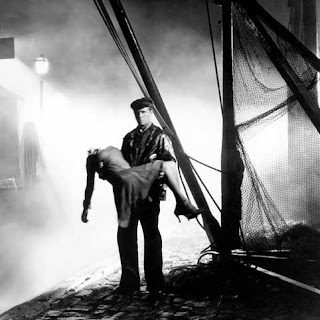Well, after weeks in the wilderness I'm back, folks. Thing is, I'm all dried up, been too busy to watch anything, haven't watched anything in ages, and feel cinematically-shrivelled. So so so so much to catch up on, film-wise, which kind of feels like the story of my life this year. The list of films released in 2010 that I wanted to see but haven't viewed yet is so large the damn thing nearly has it's own postcode. Sigh.
But...I'm back on, eyes ready and willing for some cinephiliac delight. (Something about that phrase seems oh so wrong. Am I the only person who thinks the word 'cinephile' sounds just a little too perverse? Am I also the only person round here who still uses the word, in a naïve, devil-may-care fashion, while thinking it veers too close to the borders of Wrong Town?)
Being a music fiend as much a film fiend, I was recently distracting myself from my work by playing catch-up with some sounds, via the usual vid-sharing sites. Having been intrigued by the whole Hypnagogic Pop shenanigans going around the past year or two, I was browsing browsing browsing, listening mostly to audio-only uploads to get a sense of various sounds/ acts/ etc. In my vid-sharing meanderings, I stumbled across a handful of music videos that were an awkward mixture of beguiling and odd. For those who may not know, Hypnagogic Pop is a gangly ill-fitting label for a style of music that sounds like some kind of druggy dream of the 80's – it's as if the glossy dayglo sheen of the sleek'n'synthy 80's has been strip-mined and recycled into a psychedelic lo-fi blur. Like being haunted by the dream of a decade, while under the influence. And these music videos look like a hazy and haunted equivalent to the music, chopping up what appears to be old segments from bygone commercials, TV shows, god-knows-what, and applying a film of grainy haze over the top, or making them morph into a gluey mess, or applying the digital rips and tears of mosaic corruption. I found these little visual dollops oddly engrossing, mostly because at times I felt like I was watching a haunted audiovisual archive, images hauling themselves through time, desperately attempting to kickstart back into life. Is it possible to argue that these little beasts are almost like short experimental films? Or am I so starved for cinematic stimulation that I'm inadvertently digging a film-blogging hole for myself?
I'll include a few here, if you're at all interested. If the music makes you want to bark at the screen, then try watching the vids without sound – its more trippy and you might even wish to abuse a substance. I'm onto my fifth packet of M&M's in a row, and I'm beginning to jiggle.
(Yes, this may well be a poor substitute for writing about film, but I'm a bit knackered, so think of this as a light musical interlude. Or just wait patiently for an actual film-related post in a day or two).
1. MATRIX METALS - "Tanning Salon Part Two"
2. DUCKTAILS - "Parasailing"
3. SUN ARAW - "Horse Steppin'"
4. GAMES - "Shadows In Bloom"
5. PARTY TRASH - "Beast"






